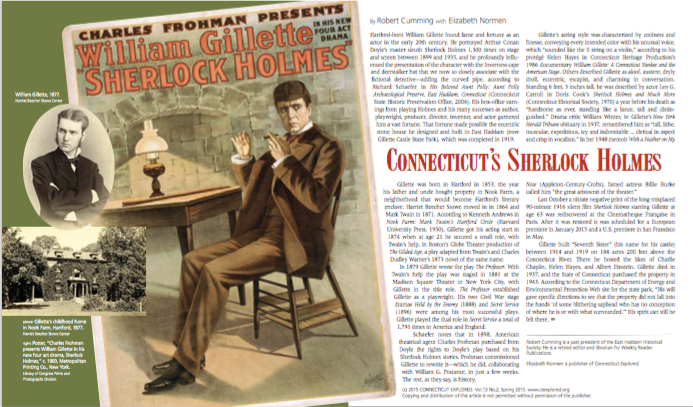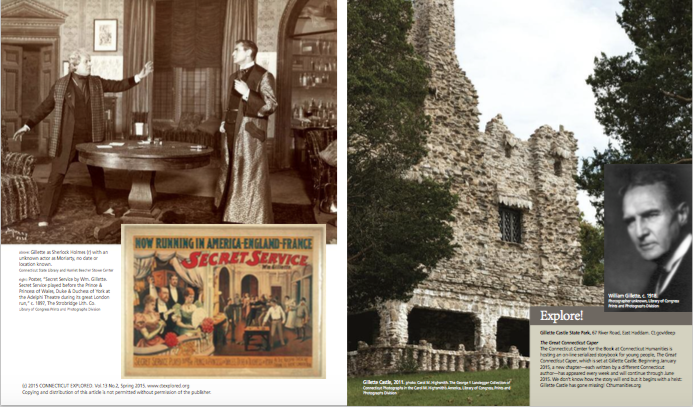By Robert Cumming with Elizabeth Normen
(c) Connecticut Explored, Inc. Spring 2015
Subscribe/Buy the Issue!
 Hartford-born William Gillette found fame and fortune as an actor in the early 20th century. He portrayed Arthur Conan Doyle’s master sleuth Sherlock Holmes 1,300 times on stage and screen between 1899 and 1935, and he profoundly influenced the presentation of the character with the Inverness cape and deerstalker hat that we now so closely associate with the fictional detective—adding the curved pipe, according to Richard Schaefer in His Beloved Aunt Polly: Aunt Polly Archaeological Preserve, East Haddam, Connecticut (Connecticut State Historic Preservation Office, 2004). His box-office earnings
from playing Holmes and his many successes as author, playwright, producer, director, inventor, and actor garnered him a vast
fortune. That fortune made possible the eccentric stone house he designed and built in East Haddam (now Gillette Castle State Park), which was completed in 1919.
Hartford-born William Gillette found fame and fortune as an actor in the early 20th century. He portrayed Arthur Conan Doyle’s master sleuth Sherlock Holmes 1,300 times on stage and screen between 1899 and 1935, and he profoundly influenced the presentation of the character with the Inverness cape and deerstalker hat that we now so closely associate with the fictional detective—adding the curved pipe, according to Richard Schaefer in His Beloved Aunt Polly: Aunt Polly Archaeological Preserve, East Haddam, Connecticut (Connecticut State Historic Preservation Office, 2004). His box-office earnings
from playing Holmes and his many successes as author, playwright, producer, director, inventor, and actor garnered him a vast
fortune. That fortune made possible the eccentric stone house he designed and built in East Haddam (now Gillette Castle State Park), which was completed in 1919.
Gillette was born in Hartford in 1853, the year his father and uncle bought property in Nook Farm, a neighborhood that would become Hartford’s literary enclave. Harriet Beecher Stowe moved in in 1864 and Mark Twain in 1871. According to Kenneth Andrews in Nook Farm: Mark Twain’s Hartford Circle (Harvard University Press, 1950), Gillette got his acting start in 1874 when at age 21 he secured a small role, with Twain’s help, in Boston’s Globe Theater production of The Gilded Age, a play adapted from Twain’s and Charles Dudley Warner’s 1873 novel of the same name.
In 1879 Gillette wrote the play The Professor. With Twain’s help the play was staged in 1881 at the Madison Square Theater in New York City, with Gillette in the title role. The Professor established Gillette as a playwright. His two Civil War stage dramas Held by the Enemy (1888) and Secret Service (1896) were among his most successful plays. Gillette played the dual role in Secret Service a total of 1,791 times in America and England.
Schaefer notes that in 1898, American theatrical agent Charles Frohman purchased from Doyle the rights to Doyle’s play based on his Sherlock Holmes stories. Frohman commissioned Gillette to rewrite it—which he did, collaborating with William G. Postance, in just a few weeks. The rest, as they say, is history.
 Gillette’s acting style was
characterized by coolness and finesse, conveying every intended color with his unusual voice, which “sounded like the E string on a violin,” according to his protégé Helen Hayes in Connecticut Heritage Production’s 1986 documentary William Gillette: A Connecticut Yankee and the American Stage. Others described Gillette as aloof, austere, dryly droll, eccentric, escapist, and charming in conversation. Standing 6 feet, 3 inches tall, he was described by actor Leo G. Carroll in Doris Cook’s Sherlock Holmes and Much More (Connecticut Historical Society, 1970) a year before his death as “handsome as ever, standing like a lance, tall and distinguished.” Drama critic William Winter, in Gillette’s
New York Herald Tribune obituary in 1937, remembered him as “tall, lithe, muscular, expeditious, icy and indomitable … clerical in aspect and crisp in vocalism.” In her 1948 memoir With a Feather on My Nose (Appleton-Century-Crofts), famed actress Billie Burke called him “the great aristocrat of the theater.”
Gillette’s acting style was
characterized by coolness and finesse, conveying every intended color with his unusual voice, which “sounded like the E string on a violin,” according to his protégé Helen Hayes in Connecticut Heritage Production’s 1986 documentary William Gillette: A Connecticut Yankee and the American Stage. Others described Gillette as aloof, austere, dryly droll, eccentric, escapist, and charming in conversation. Standing 6 feet, 3 inches tall, he was described by actor Leo G. Carroll in Doris Cook’s Sherlock Holmes and Much More (Connecticut Historical Society, 1970) a year before his death as “handsome as ever, standing like a lance, tall and distinguished.” Drama critic William Winter, in Gillette’s
New York Herald Tribune obituary in 1937, remembered him as “tall, lithe, muscular, expeditious, icy and indomitable … clerical in aspect and crisp in vocalism.” In her 1948 memoir With a Feather on My Nose (Appleton-Century-Crofts), famed actress Billie Burke called him “the great aristocrat of the theater.”
In October 2014 a nitrate negative print of the long misplaced 90-minute 1916 silent film Sherlock Holmes starring Gillette at age 63 was rediscovered at the Cinematheque Française in Paris. After it was restored it was scheduled for a European premiere in January 2015 and a U.S. premiere in San Francisco in May.
Gillette built “Seventh Sister” (his name for his castle) between 1914 and 1919 on 184 acres 200 feet above the Connecticut River. There he hosted the likes of Charlie Chaplin, Helen Hayes, and Albert Einstein. Gillette died in 1937, and the State of Connecticut purchased the property in 1943. According to the Connecticut Department of Energy and Environmental Protection website for the state park, “His will gave specific directions to see that the property did not fall into the hands ‘of some blithering saphead who has no conception of where he is or with what surrounded.’” His spirit can still be found there.
Robert Cumming is a past president of the East Haddam Historical Society. He is a retired editor and librarian for Weekly Reader Publications.
Explore!
Gillette Castle State Park, 67 River Road, East Haddam. Ct.gov/deep
The Great Connecticut Caper
The Connecticut Center for the Book at Connecticut Humanities hosted an on-line serialized storybook for young people, The Great Connecticut Caper, which was set at Gillette Castle. Beginning January 2015, a new chapter—each written by a different Connecticut author—appeared every week through June 2015. It begins with a heist: Gillette Castle has gone missing! Cthumanities.org
